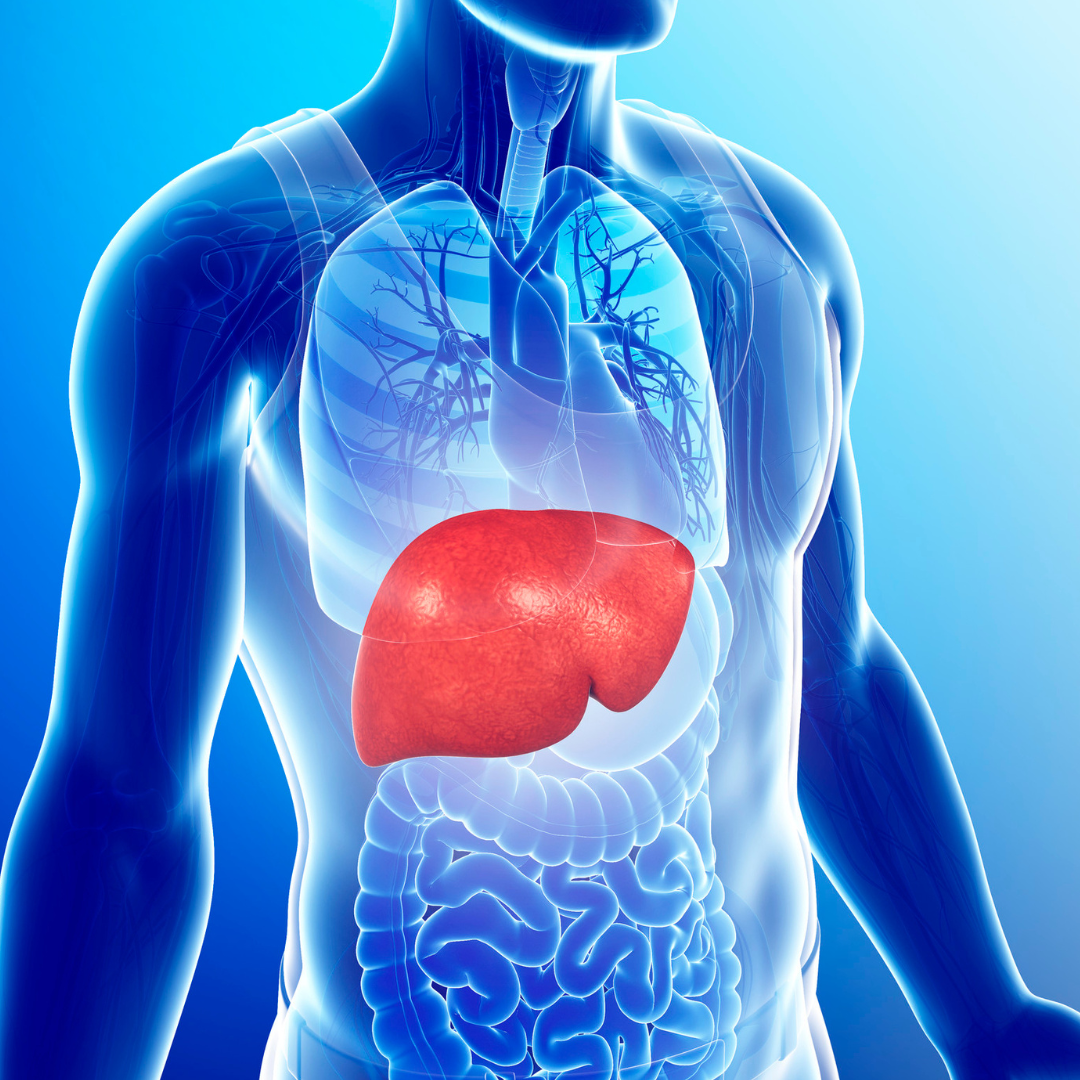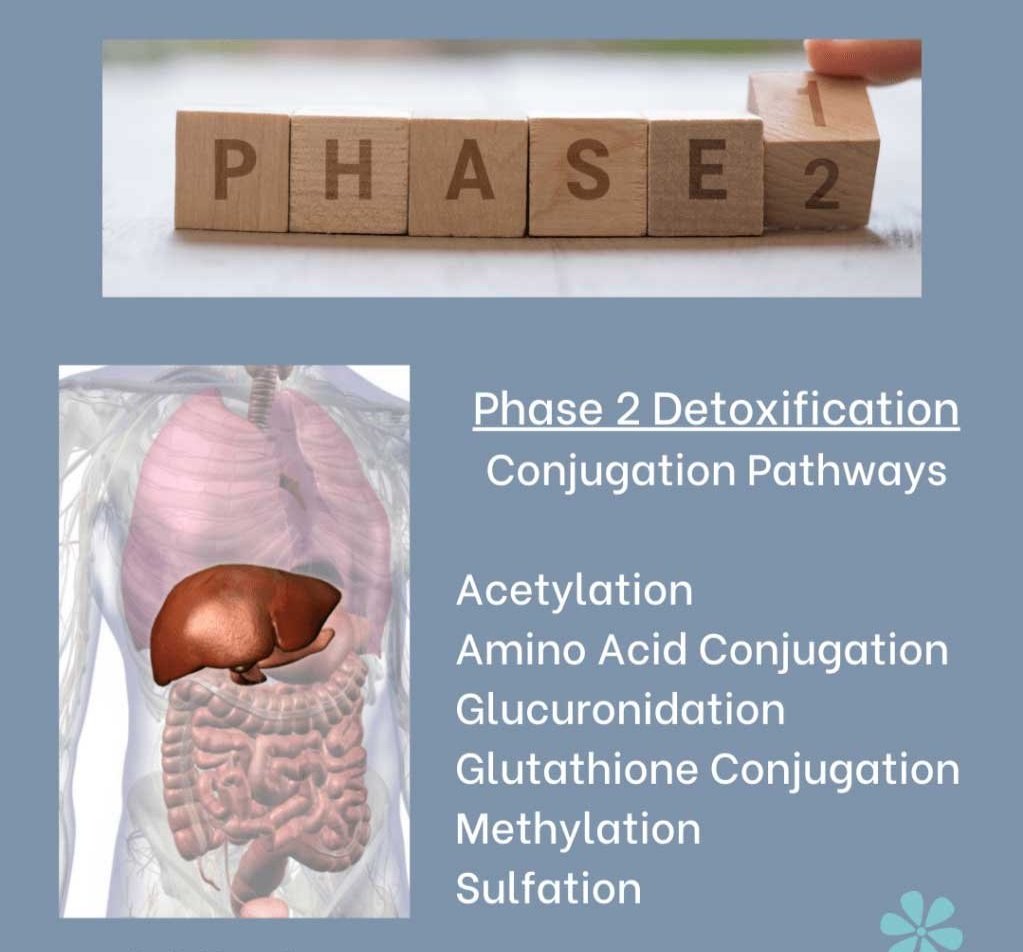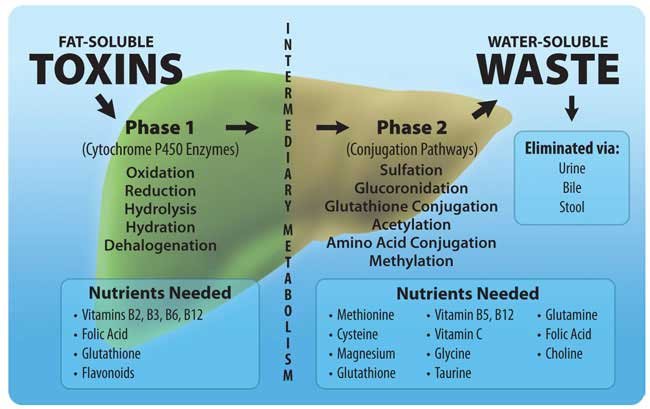In the previous post, Love Your Liver | Part 1, how your liver functions in conjunction with your lymphatic system to remove waste products was introduced. In this post we will dive a little deeper on the two phases of liver detoxification and why knowing …
In the previous post, Love Your Liver | Part 1, how your liver functions in conjunction with your lymphatic system to remove waste products was introduced.
In this post we will dive a little deeper on the two phases of liver detoxification and why knowing how to support it with the right materials can make or break your weight loss and health journey.
Your liver is the king of all filters. It not only traps, it also disarms and then prepares toxic waste for safe removal.
Phase 1 (Functionalization) of liver detoxification uses enzymes to breakdown the toxic waste of our cells into intermediate metabolites. Sometimes those metabolites are more hazardous during this phase. This phase makes the more hazardous metabolites water soluble and prepares them for Phase 2 detoxification.
Phase 2 (Conjugation) of liver detoxification binds those water soluble molecules and sends them through one of six pathways to eventually be escorted out of the body.
The liver is the true hero in detoxification for our entire body. When we feed our body a nutrient dense meal, our body can function more efficiently. When we eat a nutrient devoid meal, our body struggles. It may take a few poorly chosen meals for us to start to feel fatigued, achy, and moody, but that doesn’t mean we aren’t affected.
I’ve felt it. I know you’ve felt it, too.
Remember: One bad meal doesn’t destroy your waistline, mood, or energy levels and one good meal doesn’t completely restore those markers either.
We have to be consistent to see the results we want.
Let’s dig a little deeper into those two phases of detoxification, so you are better equipped to love your liver a little better.
Phase 1 Liver Detoxification
This is the ‘subtraction’ or ‘division’ phase. Digestion starts in your brain with the thoughts of eating kickstarting your saliva glands, but it doesn’t end in your intestines. Your liver must breakdown the molecules delivered to it even further. This process is completely dependent upon enzymes from the Cytochrome P450 family to do its job.
Phase 1 detoxification is the first line of defense against toxic waste for this stage in digestion. In this phase, your liver is breaking down the waste products delivered to it. Your stomach acid, when at appropriate levels at the right times, should neutralize most of the dangerous pathogens and offending agents before it gets to the liver. This is where the broken down materials undergo oxidation, reduction, hydrolysis, hydration, and/or dehalogenation. The toxic materials are broken down and lipids are made water soluble. Bile is a key component to this phase. Phase 1 pathway is activated by caffeine, alcohol, dioxin, paint fumes, steroids, pesticides, sleeping pills, contraceptive pills, and cortisone.
Phase 1 causes oxidation, resulting in free radicals. We want those free radicals to keep moving. If they stick around, DNA damage can occur.
Phase 2 Liver Detoxification
This is where is gets a little more complicated. Once the offending molecules are broken down and made water soluble by the Phase 1 pathway, some of those become more toxic or hazardous. Those more toxic molecules are conjugated – a molecule is attached to them – to be marked ‘safe’ for transportation out of our body.
Six pathways are available to complete the conjugation phase:
-
Acetylation
-
Glucuronidation
-
Glutathione conjugation
-
Methylation
-
Peptide (Amino Acid) conjugation
-
Sulfation
Each pathway is compromised by medications, hormone metabolite congestion, specific foods, air pollution, and/or other waste products the body may produce. Some pathways share similar compounds that help or hurt and some pathways need more support than others.
The following are very simplified overviews of each of the pathways. It’s a lot of science, but I’ve compressed it into smaller, understandable chunks.
ACETYLATION
Acetylation is responsible for the metabolism of caffeine, Benzodiazepines , Isoniazid, Hydralazine, Sulphonamides, histamine, and aromatic amines (like cigarette smoke, pollution, diesel exhaust, etc.). This pathway is genetically controlled using the NAT-2 enzyme (N-alpha-acetyltransferase). NAT-2 is also primarily responsible for liver detoxification – for the liver to ‘clean’ itself.
GLUCURONIDATION
The Glucuronidation pathway is primarily responsible for metabolism of hormones (estrogens, androgens, T3 and T4), bilirubin, and medications. Between 40-70% of medications go through this pathway to be neutralized prior to removal. Glucuronidation requires adequate levels of glucuronic acids and uses UDP-glucuronyltransferase (UGT). The disarmed end products of this pathway are excreted in bile and urine. This pathway can be impaired by the genetic mutation of the UGT-1 gene (Gilbert’s syndrome) or a reabsorption of the metabolites in the intestines (seen in estrogen dominance).
GLUTATHIONE CONJUGATION
Glutathione conjugation is primarily responsible for the breakdown and removal of environmental toxic substances we are surrounded with on a daily basis. This pathway uses glutathione S transferase (GST) which is dependent upon glutathione (made up of cysteine, glutamine, and glycine). Glutathione is the hero of the antioxidants and one of the most common recommended supplements to support overall liver function. This pathway neutralizes mycotoxins (like mold), pesticides, herbicides, heavy metals/industrial toxins (like cadmium, mercury, lead, and arsenic), and medications (like Tylenol and alcohol). Glutathione deficiency is common in chronic illnesses.
METHYLATION
The Methylation pathway breaks down steroid hormones (estrogen), catecholemines (norepinephrine, epinephrine, and dopamine), histamine, phenols (found in coal tar, petroleum, plastics, etc), heavy metals (arsenic), the use of methyl-inhibiting substances (like oral contraceptives, PPIs, sucrose, and antibiotics), and aromatic amines (like diesel fumes and cigarette smoke). Methylation genes like MTHFR and COMT are involved in the functionality of this pathway. It’s important to note that having a genetic predisposition to impaired methylation does not mean the gene is expressed. In other words, you can have the MTHFR gene, but methylation is working well. Signs of poor methylation within lab values include: increased histamine, elevated homocysteine, elevated MMA, low RBC, and low B12. Please do not isolate lab values and self-diagnose.
PEPTIDE CONJUGATION
There are several names for this pathway. This pathway revolves around the conjugation of proteins called amino acids. Amino acids are our body’s primary building blocks for almost everything. Peptides are groups of amino acids held together by bonds. One of the most common peptide conjugations is glycination. This pathway is used to breakdown salicylate (like in alka seltzer and aspirin, as well as some fruits, veggies, seeds, nuts, and food dyes) and benzonate (found in food preservatives). This pathways breaks down a wide range of food and medicinal compounds.
SULFATION
The Sulfation pathway is dependent upon inorganic sulfate to work properly. Organic compounds contain carbon, while inorganic means it do not. This pathway breaks down used up steroid and thyroid hormones (estrogens, progesterone, DHEA, melatonin, T3, and T4), xenobiotics (like BPA, triclosan, and BHT), and catecholamines (norepinephrine, epinephrine, and dopamine). Low activity of the sulfation pathway can be tied to a low protein diet and low magnesium levels. Autism, asthma, chronic fatigue syndrome, degenerative joint disorders, intestinal disorders, lupus, neurodegenerative conditions, and migraines are connected to dysfunction of this pathway.
Soooo…
What can you do right now?
Be aware of what you are eating. Journal if needed. I don’t recommend tracking calories. Protein is where
Remove preservatives, eat a nutrient-dense whole food diet.
Be as consistent as possible.
Remember: One good meal won’t save you, just as one bad meal won’t ruin you.
Whichever you eat more of will either strain or support your liver.
Everything is processed in your liver. Helping your body by removing the most common irritating agents will help tremendously.
The liver is essential to life. You can’t live without it. Support it and it will support you. In the next post, we will investigate how to support each pathway nutritionally or with supplements.
As always, consult your healthcare provider prior to adding or removing any supplements, medications, or starting a new routine.
Are you ready to support your liver better? Book a free consult HERE
References:
Detoxification Pathways in the Liver




Comments